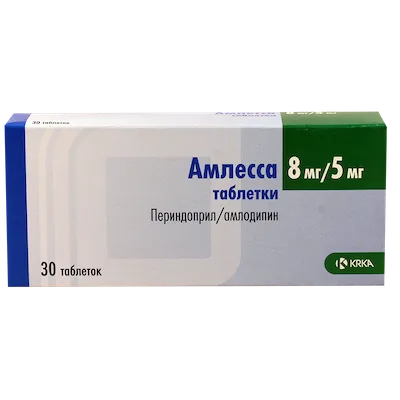Description
Amlessa (Perindopril Tert-Butylamine) Tablets 8 mg/5 mg. №30
Composition
Active ingredient: Perindopril tert-butylamine
Mechanism of Action
Perindopril, an ACE inhibitor, blocks the production of angiotensin II, a vasoconstrictor, and stimulator of aldosterone secretion. By inhibiting angiotensin-converting enzyme, perindopril reduces blood pressure, improves cardiac function, and decreases the strain on the heart.
Pharmacological Properties
Perindopril not only lowers blood pressure but also exhibits cardioprotective effects by enhancing cardiac performance and reducing cardiovascular strain. It is effective in managing hypertension and heart failure.
Indications for Use
Amlessa tablets are indicated for the treatment of hypertension and heart failure in patients requiring ACE inhibitor therapy.
Contraindications
Avoid using Amlessa tablets if pregnant, breastfeeding, have a history of angioedema, or kidney disease. Consult a healthcare provider before initiating therapy.
Side Effects
Common side effects of Amlessa tablets may include dizziness, cough, hypotension, and hyperkalemia. Inform your healthcare provider if any adverse reactions occur.
Usage Instructions
Take one tablet of Amlessa orally once daily, preferably in the morning before a meal, with a full glass of water. Adhere to the dosage regimen prescribed by your healthcare provider.
Benefits Compared to Analogues
Compared to other ACE inhibitors, perindopril demonstrates similar efficacy in lowering blood pressure and improving cardiac outcomes. However, it may offer a better tolerability profile in certain patient populations, making it a preferred choice for long-term management of hypertension and heart failure.
Suitable Patient Groups
Amlessa tablets are suitable for adult patients with hypertension and heart failure. Dosage adjustments may be necessary for elderly individuals or those with renal impairment.
Storage and Shelf Life
Store Amlessa tablets in a cool, dry place away from direct sunlight. Check the packaging for the expiry date and do not use the product beyond the stated shelf life.
Packaging Description
Amlessa tablets are available in packs of 30 tablets. Each tablet contains 8 mg of perindopril tert-butylamine and 5 mg of the active ingredient.
Clinical Evidence and Proven Effectiveness
Pharmacological studies have demonstrated the efficacy of perindopril in reducing blood pressure and improving cardiac function. Research published in the Journal of Hypertension indicates that perindopril reduces cardiovascular events and mortality in hypertensive patients. Clinical trials have shown that perindopril, as an ACE inhibitor, is effective in managing heart failure and hypertension.




